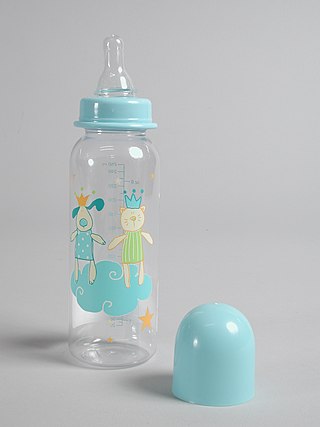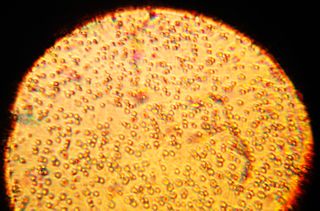
Infant formula, baby formula, or simply formula ; or baby milk or infant milk, is a manufactured food designed and marketed for feeding to babies and infants under 12 months of age, usually prepared for bottle-feeding or cup-feeding from powder or liquid. The U.S. Federal Food, Drug, and Cosmetic Act (FFDCA) defines infant formula as "a food which purports to be or is represented for special dietary use solely as a food for infants by reason of its simulation of human milk or its suitability as a complete or partial substitute for human milk".

A baby bottle, nursing bottle, or feeding bottle is a bottle with a teat attached to it, which creates the ability to drink via suckling. It is typically used by infants and young children, or if someone cannot drink from a cup, for feeding oneself or being fed. It can also be used to feed non-human mammals.

A breast pump is a mechanical device that lactating women use to extract milk from their breasts. They may be manual devices powered by hand or foot movements or automatic devices powered by electricity.

A wet nurse is a woman who breastfeeds and cares for another's child. Wet nurses are employed if the mother dies, or if she is unable or chooses not to nurse the child herself. Wet-nursed children may be known as "milk-siblings", and in some cultures, the families are linked by a special relationship of milk kinship. Wet-nursing existed in cultures around the world until the invention of reliable formula milk in the 20th century. The practice has made a small comeback in the 21st century.

Breast milk or mother's milk is milk produced by mammary glands located in the breast of a human female. Breast milk is the primary source of nutrition for newborns, containing fat, protein, carbohydrates and variable minerals and vitamins. Breast milk also contains substances that help protect an infant against infection and inflammation, whilst also contributing to healthy development of the immune system and gut microbiome.
A boycott was launched in the United States on July 4, 1977, against the Swiss-based multinational food and drink processing corporation Nestlé. The boycott expanded into Europe in the early 1980s and was prompted by concerns about Nestlé's "aggressive marketing" of infant formulas, particularly in underdeveloped countries. The boycott has been cancelled and renewed because of the business practices of Nestlé and other substitute manufacturers monitored by the International Baby Food Action Network (IBFAN). Organizers of the boycott as well as public health researchers and experts consider breast milk to be the best nutrition source for infants. The World Health Organization (WHO) recommends infants to be exclusively breastfed for the first six months of their lives, nevertheless, sometimes nutritional gaps need to be filled if breastfeeding is unsuitable, not possible, or inadequate.

A supplemental nursing system (SNS), also known as a lactation aid, is a device that consists of a container and a capillary tube. It is used to provide additional nutrients to a baby whose mother has low milk supply. During breastfeeding, the end of the tube is placed alongside the mother's nipple so that both the tube and the breast are in the infant's mouth.

Goat milk is the milk of domestic goats. Goats produce about 2% of the world's total annual milk supply. Some goats are bred specifically for milk. Goat milk naturally has small, well-emulsified fat globules, which means the cream will stay in suspension for a longer period of time than cow's milk; therefore, it does not need to be homogenized. Eventually, the cream will rise to the top over a period of a few days. If the milk is to be used to make cheese, homogenization is not recommended, as this changes the structure of the milk, affecting the culture's ability to coagulate the milk and the final quality and yield of cheese.
A human milk bank is "a service which collects, screens, processes, and dispenses by prescription human milk donated by nursing mothers who are not biologically related to the recipient infant". As of November 2019, there are 28 milk banks in North America that are members of the Human Milk Banking Association of North America (HMBANA). They are usually housed in hospitals, although some are free standing. Members of HMBANA follow the annually revised "Guidelines for the Establishment and Operation of a Donor Human Milk Bank" which include protocols for soliciting donors and collecting, processing, and distributing the milk. In addition, some states have required standards for donor human milk banks. However, the Food and Drug Administration (FDA), states that "the FDA has not been involved in establishing these voluntary guidelines or state standards." Some of these protocols are described below.

Breastfeeding difficulties refers to problems that arise from breastfeeding, the feeding of an infant or young child with milk from a woman's breasts. Although babies have a sucking reflex that enables them to suck and swallow milk, and human breast milk is usually the best source of nourishment for human infants, there are circumstances under which breastfeeding can be problematic, or even in rare instances, contraindicated.

Breastfeeding, or nursing, is the process by which human breast milk is fed to a child. Breast milk may be from the breast, or may be expressed by hand or pumped and fed to the infant. The World Health Organization (WHO) recommends that breastfeeding begin within the first hour of a baby's life and continue as often and as much as the baby wants. Health organizations, including the WHO, recommend breastfeeding exclusively for six months. This means that no other foods or drinks, other than vitamin D, are typically given. WHO recommends exclusive breastfeeding for the first 6 months of life, followed by continued breastfeeding with appropriate complementary foods for up to 2 years and beyond. Of the 135 million babies born every year, only 42% are breastfed within the first hour of life, only 38% of mothers practice exclusive breastfeeding during the first six months, and 58% of mothers continue breastfeeding up to the age of two years and beyond.

Lactation describes the secretion of milk from the mammary glands and the period of time that a mother lactates to feed her young. The process naturally occurs with all sexually mature female mammals, although it may predate mammals. The process of feeding milk in all animals is called nursing, and in humans it is also called breastfeeding. Newborn infants often produce some milk from their own breast tissue, known colloquially as witch's milk.
The International Breast Milk Project is a non-profit organization that solicits donations of human milk and provides the milk to needy infants.

A human milk bank, breast milk bank or lactarium is a service that collects, screens, processes, and dispenses by prescription human milk donated by nursing mothers who are not biologically related to the recipient infant. The optimum nutrition for newborn infants is breastfeeding, if possible, for the first year. Human milk banks offer a solution to the mothers that cannot supply their own breast milk to their child, for reasons such as a baby being at risk of getting diseases and infections from a mother with certain diseases, or when a child is hospitalized at birth due to very low birth weight, and the mother cannot provide her own milk during the extended stay for reasons such as living far from the hospital.

Mary Rose Tully MPH IBCLC was an American lactation consultant, director of the Department of Lactation Services at the University of North Carolina's Women's Hospital, and an adjunct clinical instructor of pediatrics at the University of North Carolina's School of Medicine. She researched and helped to expand knowledge of human breast milk. In the mid-1970s, she helped establish the non-profit Piedmont Milk Bank, now known as the WakeMed Mothers' Milk Bank and Lactation Center located in Raleigh, North Carolina. She was a founding member of the Human Milk Banking Association of North America in 1985 and received a lifetime achievement award from the organization in 2007.
Infant feeding is the practice of feeding infants. Breast milk provides the best nutrition when compared to infant formula. Infants are usually introduced to solid foods at around four to six months of age.
In breastfeeding women, low milk supply, also known as lactation insufficiency, insufficient milk syndrome, agalactia, agalactorrhea, hypogalactia or hypogalactorrhea, is the production of breast milk in daily volumes that do not fully meet the nutritional needs of her infant.

Human milk immunity is the protection provided to the immune system of an infant via the biologically active components in human milk. Human milk was previously thought to only provide passive immunity primarily through Secretory IgA, but advances in technology have led to the identification of various immune-modulating components. Human milk constituents provide nutrition and protect the immunologically naive infant as well as regulate the infant's own immune development and growth.

Delayed onset of lactation (DOL) describes the absence of copious milk secretion (onset of lactation) within the first 72 hours following childbirth. It affects around 20-40% of lactating women, the prevalence differs among distinct populations.

In 2022, the United States experienced a severe shortage of infant formula as a result of the 2021–2022 global supply chain crisis compounded by a large scale product recall after two babies allegedly died after consuming Abbott infant formula, import restrictions, and market concentration. Unlike other food products, infant formula often does not have an available and acceptable substitute as a source of nutrition for those who rely on it. In addition to infants, the formula recalls affected non-infant medical patients who require nasogastric feeding or have certain other conditions.













